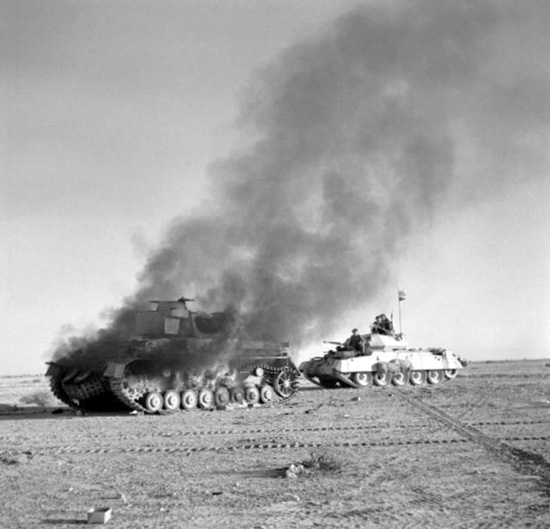
A British Crusader passes a burning Panzer IV during Operation Crusader on 27 November 1941. British tank armament, comprising the 2-pounder gun, was wholly inadequate against the Panzer III and IV.
On the eve of the Second World War Hitler’s Wehrmacht had just over 3,300 tanks, of which only 629 were Panzer III and IV. By May 1940 every tank detachment had a medium tank company of six to eleven Panzer IVs. When the invasion of France and the Low Countries commenced there were 280 Ausf A, B, C and D Mk IVs equipping the panzer divisions. After the defeat of France some of these were sent to North Africa to help the Italians.
When the armoured units of Rommel’s Deutsches Afrika Korps (DAK) arrived in Libya they were equipped with the Panzer IV Ausf C and D and then later the Ausf E and F1, armed with the 75mm KwK L/24 gun that fired the same high-explosive projectile as the Ausf F2 (dubbed the Panzer IV ‘Special’ by the British) equipped with the L/43.
The first elements of DAK landed in Tripoli on 14 February 1941 with the disembarkation of the 3rd Reconnaissance Battalion, 5th Light Division; other units, most notably two battalions of the 5th Panzer Regiment, followed. The 5th and 8th Panzer Regiments initially took just forty Ausf D and E Mk IVs to North Africa. These regiments formed the spearhead of the 21st and 15th Panzer Divisions respectively.
Significantly, the most common Panzer IV were the Ausf D, E and F1 which made up around 25 per cent of Rommel’s armoured formations. Armed with the short 75mm KwK37 L/24 gun, they were inferior to the later 50mm gun of the Panzer III. Prior to the Crusader battles in November 1941 the British were able to field 748 tanks armed with 40mm or 37mm high-velocity guns against 248 panzers, of which 174 were Panzer III and IVs, the rest being Panzer IIs with a 20mm gun. The Italians supported Rommel with 146 inferior tanks that were armed with a low-velocity 47mm gun. What really gave Rommel an advantage was his superior tactics.
In the summer of 1942 he began to receive the up-gunned F2 armed with the longbarrelled 75mm KwK40 L/43 gun. This could punch through 85mm of armour at 1,000 yards and was superior to the British 2-pounder (40mm) and 6-pounder (57mm) and the American-supplied M3 Grant’s 75mm gun. Luckily for the British the Germans had only received twenty-seven Panzer IV F2s by August 1942, which they employed to spearhead Rommel’s counteroffensive. Despite their presence Rommel’s attack at Alam Halfa was held.
Crucially the F2 was never available in sufficient numbers, with around thirty with each of DAK’s panzer divisions at any one time compared to 100 Mk IIIs. While its gun could penetrate all British and American armour at a distance and more arrived between August and October 1942, they were nothing like the quantities of tanks reaching the British 8th Army prior to El Alamein. Some Ausf G also fought with the Germans in Tunisia.
British armour could cope with the Panzer I and II but not the subsequent two models. The Panzer III armed with a 50mm gun was superior to any Allied armour until 1942 and the arrival of the M3 Grant. The early Mk IV with its short 75mm gun was able to fire armour piercing, high explosive and smoke so could outshoot very vulnerable British cruiser tanks and shell exposed 25-pounder gun crews.
British cruiser tanks, as well as the Matilda and Valentine infantry support tanks armed with the 2-pounder gun, could only fire armour piercing rounds. Initially the 6-pounder installed on the Crusader and the Churchill was only intended to fire armour piercing. While the Panzer IV could fire from 3,000 yards with HE, British tanks had to wait for them to close to within 1,000–500 yards to engage with their solid AP shot: in the meantime their exposed artillery would have to retreat.
The Panzer III and Panzer IV F2 therefore had little trouble dealing with their opponents. British cruiser tanks such as the Mk II and IV had a maximum of 30mm of armour, while the Mk I and III were even more lightly armoured at just 14mm. The Mk VI Crusader was little better – with the final production version the Crusader III sporting 51mm of armour. It was also up-gunned to the British 6-pounder. The Matilda and Valentine had a respectable maximum of 78mm and 65mm respectively but like all British tanks were slower than the panzers and under-gunned. The Grant and Sherman had 37mm and 75mm armour respectively.
Against the F2 the Grant was not only disadvantaged by its gun, but also by the mounting the weapon in the hull instead of a fully revolving turret. This meant it could not fight dug-in from a ‘hull-down’ position when on the defensive. Likewise the Grant’s high silhouette exposed the top of the tank to enemy fire when on the offensive. The Panzer IV also proved more than a match for the Sherman in North Africa.
Ultimately though, the Panzer III and IV were overwhelmed by superior numbers and air power. Hitler never adequately reinforced his troops in North Africa until it was far too late and they were trapped. Despite the effectiveness of the Panzer IV F2 and the introduction of a few Tigers, particularly against the inexperienced American army, capitulation was inevitable. The very last of the Panzer IVs were disabled by Allied bombers – one of which was photographed on 10 May 1943 just two days before the Axis surrendered in Tunisia.
Similarly, significant numbers of Panzer IVs were never available in Italy. German panzer divisions were always thin on the ground during the Italian campaign. Generally German infantry divisions relied on the support of panzergrenadier units, which had fewer armoured fighting vehicles than the regular panzer divisions and relied on assault guns, not tanks.
The key tank unit was the 26th Panzer Division, which transferred to Italy in 1943 and remained there for the rest of the war until its surrender near Bologna in May 1945. The 16th Panzer Division only fought in Italy for six months between June and November 1943 seeing action at Salerno and Naples before being sent to the Eastern Front. These divisions were equipped with the Panzer IV Ausf G, H and J.
The Luftwaffe also fielded the Panzer IV in Italy. The Hermann Göring Panzer Division, which had been destroyed in Tunisia, was reformed in southern Italy and Sicily and played a key role in the Sicilian campaign in July and August 1943. Escaping to the Italian mainland following the Allied landings on the island it was given the title Fallschirm Panzer Division Hermann Göring, although the Fallschirm (Parachute) designation was purely honorary. The Parachute Panzer Regiment Hermann Göring included a panzer and assault gun battalion.

A British Crusader passes a burning Panzer IV during Operation Crusader on 27 November 1941. British tank armament, comprising the 2-pounder gun, was wholly inadequate against the Panzer III and IV.
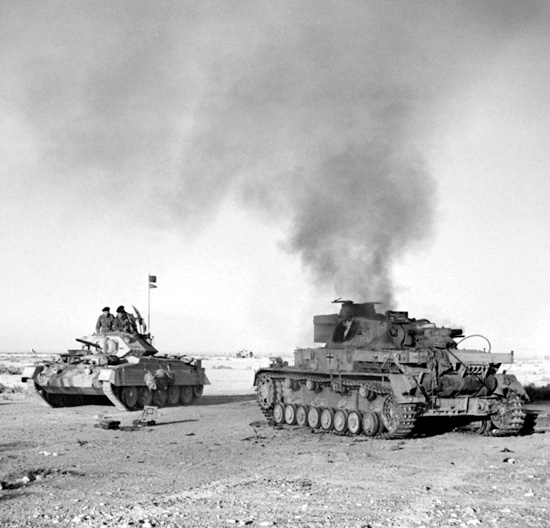
Another shot of the burning Panzer IV. The most common models in North Africa were the Ausf D, E and F1, all armed with the close-support short 75mm gun.
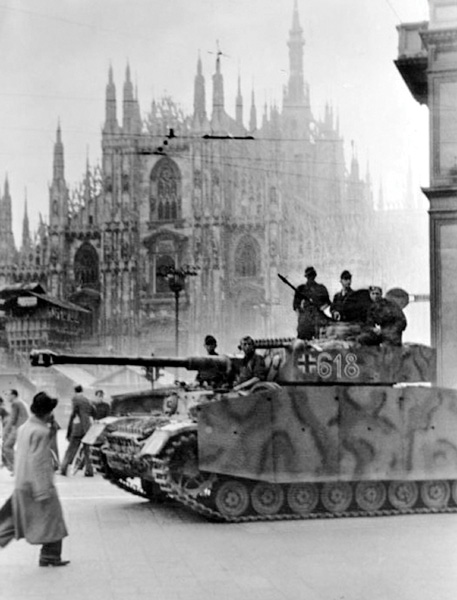
Panzer IV ‘618’ belonging to the 1st SS Panzer Division in Milan during September 1943 following the German occupation of Italy.
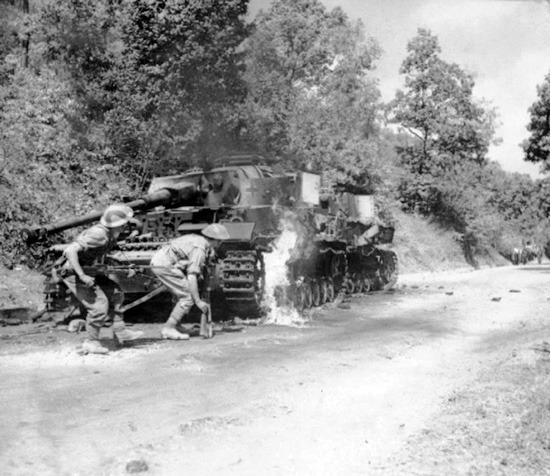
British troops sheltering by two burning Panzer IVs caught on the road near Salerno on 22 September 1943, following the landings on the Italian mainland.
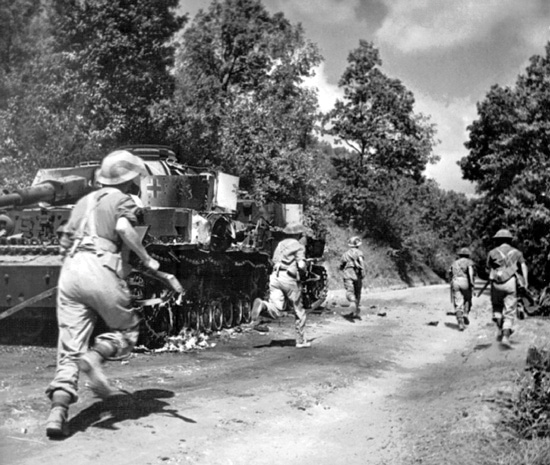
Men hurry past the same tanks. Both have the turret Schürzen but the side plates are missing.
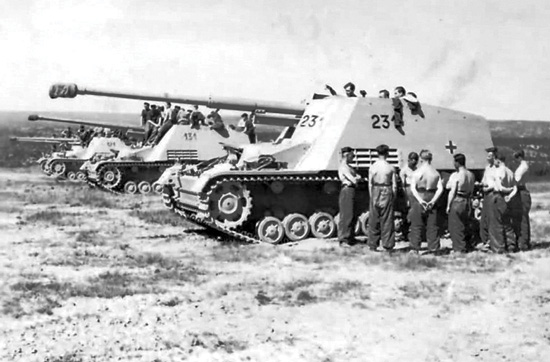
A battery of Hornisse self-propelled anti-tank guns near Anzio, Italy in 1944.
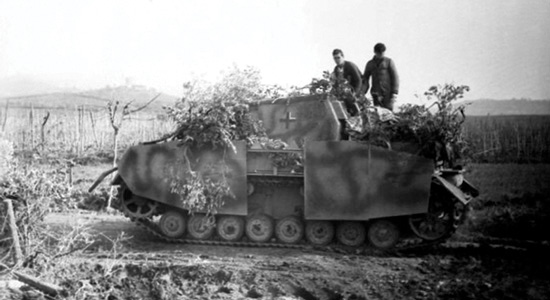
Brümmbar Sturmpanzer IV during the battle for Anzio. The Brümmbar also saw action on the Western and Eastern Fronts. This particular example has lost the central plate on the left-hand skirt.
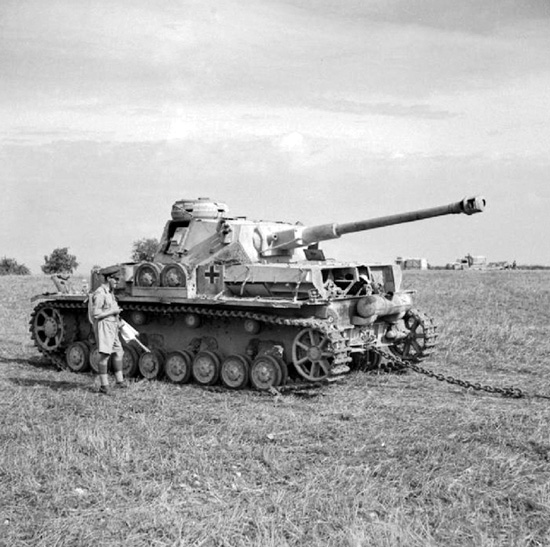
This Ausf G was photographed near Lucera in Italy on 27 October 1943. It was being used for weapons tests by the British 8th Army.
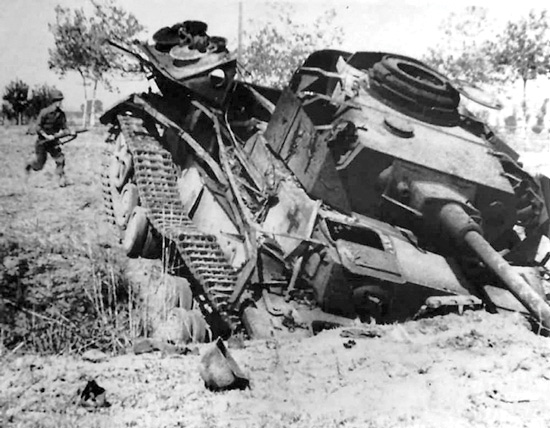
This Panzer IV Ausf H was destroyed near Salerno, Italy. The engine compartment and hull have been badly damaged by an explosion.